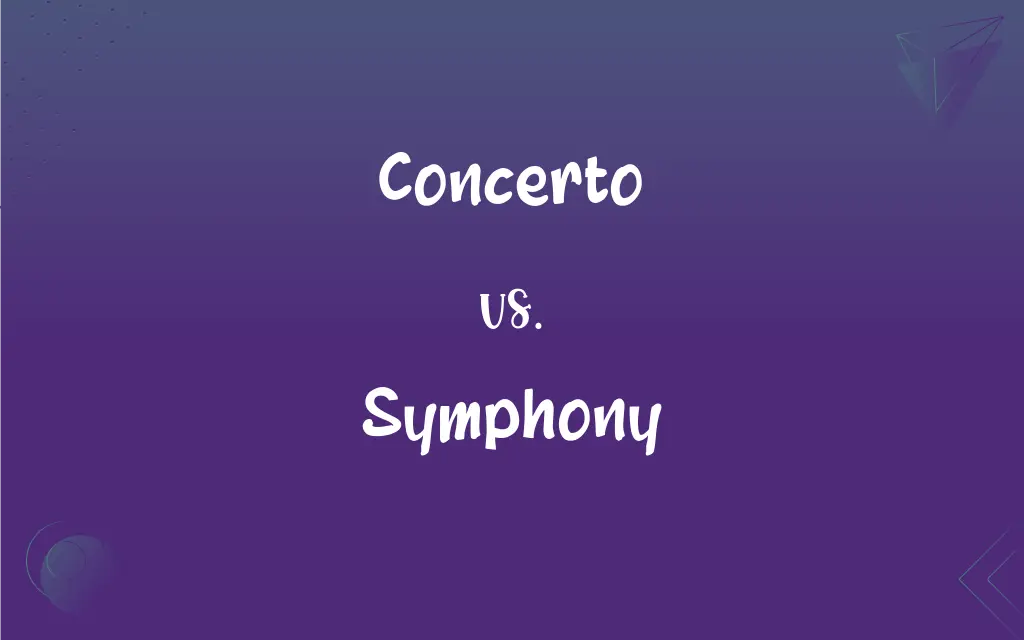Concerto vs. Symphony: What's the Difference?
By Harlon Moss & Janet White || Updated on May 20, 2024
A concerto is a musical composition for a solo instrument accompanied by an orchestra, focusing on contrast and interaction, a symphony is a large-scale orchestral work, typically in four movements, emphasizing complex structures and thematic development.

Key Differences
A concerto is a musical work typically composed for a solo instrument and orchestra, creating a dynamic interplay between the individual performer and the ensemble. The soloist's virtuosity is often highlighted, while the orchestra provides a rich harmonic and rhythmic backdrop. A symphony, on the other hand, is an extensive composition written for a full orchestra, often divided into four movements. It emphasizes thematic development and structural complexity, with no single instrument taking the spotlight as in a concerto.
In a concerto, the structure often includes three movements: fast, slow, and fast, allowing for a showcase of the soloist’s technical skills and expressive range. Symphonies, however, usually follow a four-movement format: fast, slow, minuet or scherzo, and fast, promoting thematic and harmonic exploration.
While concertos focus on the contrast between the soloist and the orchestra, creating a dialogue, symphonies are more about the cohesion and interplay within the orchestra itself. The symphony's multiple movements offer varied moods and styles, contributing to its overall narrative.
Concertos tend to feature prominent solo passages, giving the soloist opportunities for cadenza and improvisation. Symphonies, conversely, rely on the orchestra's collective sound, with each section contributing to the overall texture and complexity.
Concertos have roots in the Baroque period, with composers like Vivaldi popularizing the form. Symphonies evolved during the Classical period, with figures like Haydn and Beethoven expanding the genre's scope and depth.
ADVERTISEMENT
Comparison Chart
Structure
Typically three movements (fast-slow-fast)
Typically four movements (fast-slow-minuet/scherzo-fast)
Focus
Solo instrument with orchestral accompaniment
Full orchestra, no single spotlight
Origin
Baroque period
Classical period
Solo Passages
Prominent, includes cadenza
Minimal, focus on orchestral sections
Notable Composers
Vivaldi, Mozart, Beethoven
Haydn, Mozart, Beethoven
ADVERTISEMENT
Concerto and Symphony Definitions
Concerto
A musical composition for a solo instrument and orchestra.
The pianist performed a stunning concerto with the symphony orchestra.
Symphony
An elaborate musical composition for full orchestra.
Beethoven's Ninth Symphony is renowned for its complexity and grandeur.
Concerto
Involves a contrast between the soloist and the ensemble.
The concerto's adagio movement created a beautiful dialogue between the flute and the strings.
Symphony
Originated in the Classical period and expanded in the Romantic era.
The symphony by Brahms exemplifies the Romantic era's emotional depth.
Concerto
A work designed to showcase the skill of the soloist.
The violin concerto featured intricate passages that highlighted the soloist’s technique.
Symphony
Focuses on thematic development and orchestral texture.
The symphony's andante movement showcased the woodwinds beautifully.
Concerto
Typically structured in three movements.
The concerto began with a lively allegro movement.
Symphony
Usually consists of four movements.
The symphony opened with a dramatic allegro movement.
Concerto
Often includes a cadenza for solo improvisation.
The concerto reached its climax with a breathtaking cadenza.
Symphony
An extended piece in three or more movements for symphony orchestra.
Concerto
A composition for an orchestra and one or more solo instruments, typically in three movements.
Symphony
Does not feature a solo instrument.
Unlike a concerto, the symphony relies on the orchestra as a whole.
Concerto
(music) A piece of music for one or more solo instruments and orchestra.
Symphony
An instrumental passage in a vocal or choral composition.
Concerto
A composition (usually in symphonic form with three movements) in which one instrument (or two or three) stands out in bold relief against the orchestra, or accompaniment, so as to display its qualities or the performer's skill.
Symphony
An instrumental overture or interlude, as in early opera.
Concerto
A composition for orchestra and a soloist
Symphony
A symphony orchestra.
Symphony
An orchestral concert.
Symphony
Harmony, especially of sound or color.
Symphony
Something characterized by a harmonious combination of elements.
Symphony
An extended piece of music of sophisticated structure, usually for orchestra.
Symphony
(music) An instrumental introduction or termination to a vocal composition.
Symphony
Harmony in music or colour, or a harmonious combination of elements.
Symphony
A symphony orchestra.
Symphony
A consonance or harmony of sounds, agreeable to the ear, whether the sounds are vocal or instrumental, or both.
The trumpets sound,And warlike symphony in heard around.
Symphony
A stringed instrument formerly in use, somewhat resembling the virginal.
With harp and pipe and symphony.
Symphony
An elaborate instrumental composition for a full orchestra, consisting usually, like the sonata, of three or four contrasted yet inwardly related movements, as the allegro, the adagio, the minuet and trio, or scherzo, and the finale in quick time. The term has recently been applied to large orchestral works in freer form, with arguments or programmes to explain their meaning, such as the "symphonic poems" of Liszt. The term was formerly applied to any composition for an orchestra, as overtures, etc., and still earlier, to certain compositions partly vocal, partly instrumental.
Symphony
A long and complex sonata for symphony orchestra
Symphony
A large orchestra; can perform symphonies;
We heard the Vienna symphony
FAQs
What is a symphony?
A symphony is a large-scale orchestral composition, typically with four movements.
What is a concerto?
A concerto is a musical piece for a solo instrument accompanied by an orchestra.
How many movements does a typical concerto have?
A typical concerto has three movements.
How many movements does a typical symphony have?
A typical symphony has four movements.
Do concertos include cadenzas?
Yes, concertos often include cadenzas for solo improvisation.
What period did concertos originate in?
Concertos originated in the Baroque period.
Who are famous symphony composers?
Haydn, Mozart, and Beethoven are renowned symphony composers.
What period did symphonies originate in?
Symphonies originated in the Classical period.
What is the typical structure of a concerto?
The typical structure of a concerto includes fast, slow, and fast movements.
Who are famous concerto composers?
Vivaldi, Mozart, and Beethoven are famous for their concertos.
What is the focus of a concerto?
The focus of a concerto is the contrast between the soloist and the orchestra.
What is the typical structure of a symphony?
The typical structure of a symphony includes fast, slow, minuet/scherzo, and fast movements.
Can a symphony be performed by a small ensemble?
No, a symphony is designed for a full orchestra, unlike chamber music which can be performed by a small ensemble.
Do symphonies feature solo instruments?
No, symphonies do not typically feature solo instruments in the same way concertos do.
What is the focus of a symphony?
The focus of a symphony is the thematic and harmonic development within the orchestra.
About Author
Written by
Harlon MossHarlon is a seasoned quality moderator and accomplished content writer for Difference Wiki. An alumnus of the prestigious University of California, he earned his degree in Computer Science. Leveraging his academic background, Harlon brings a meticulous and informed perspective to his work, ensuring content accuracy and excellence.
Co-written by
Janet WhiteJanet White has been an esteemed writer and blogger for Difference Wiki. Holding a Master's degree in Science and Medical Journalism from the prestigious Boston University, she has consistently demonstrated her expertise and passion for her field. When she's not immersed in her work, Janet relishes her time exercising, delving into a good book, and cherishing moments with friends and family.































































